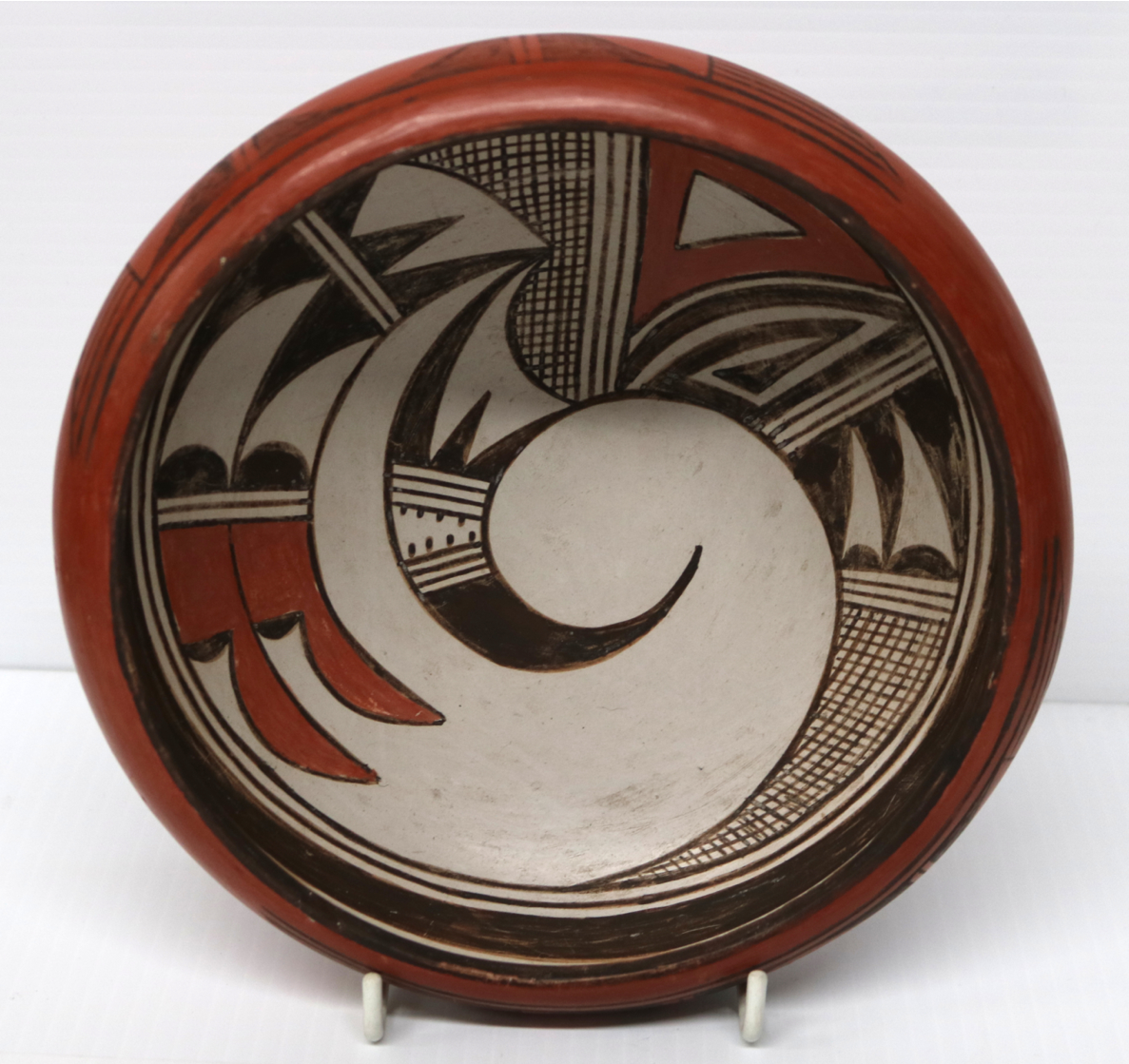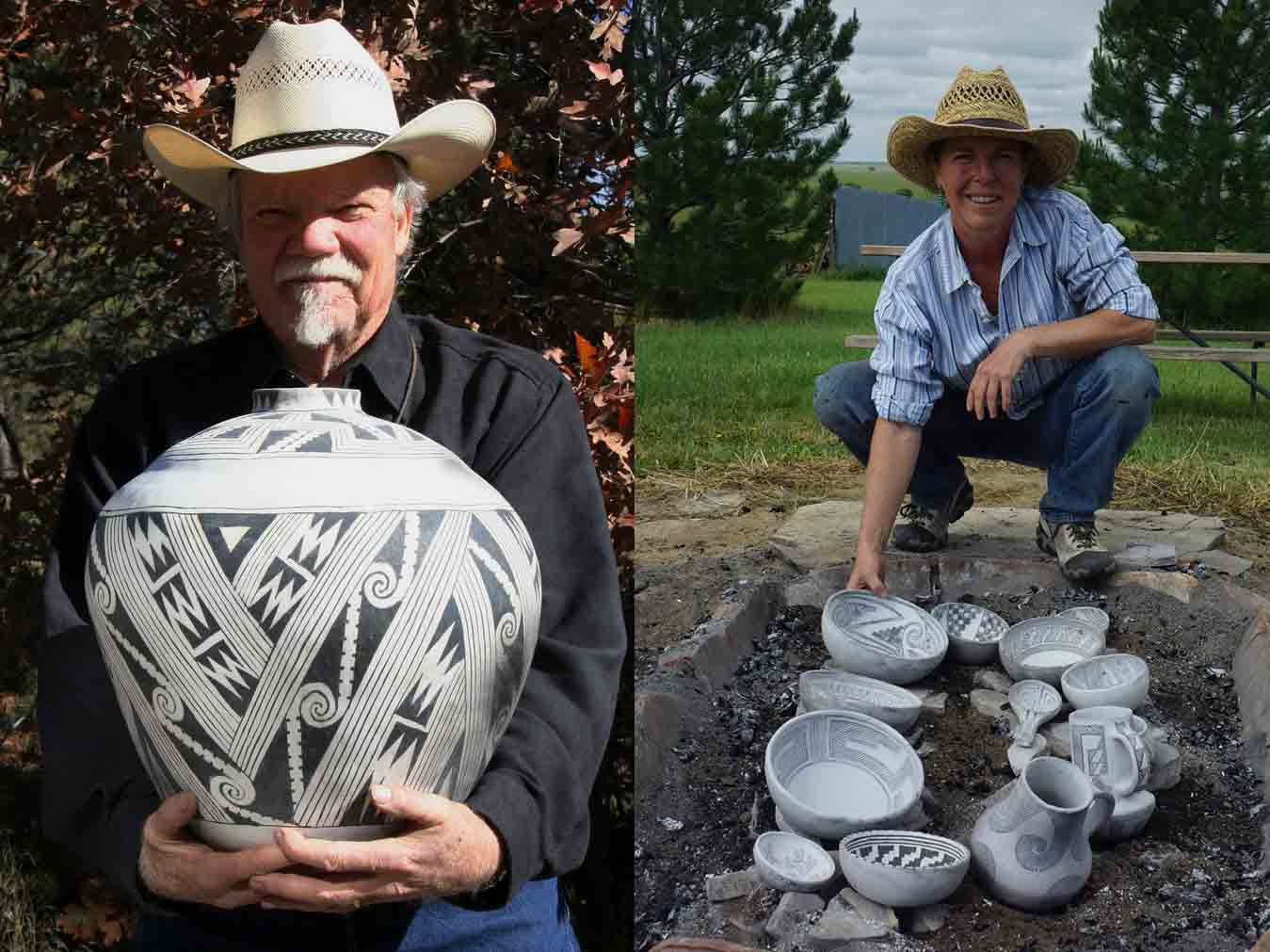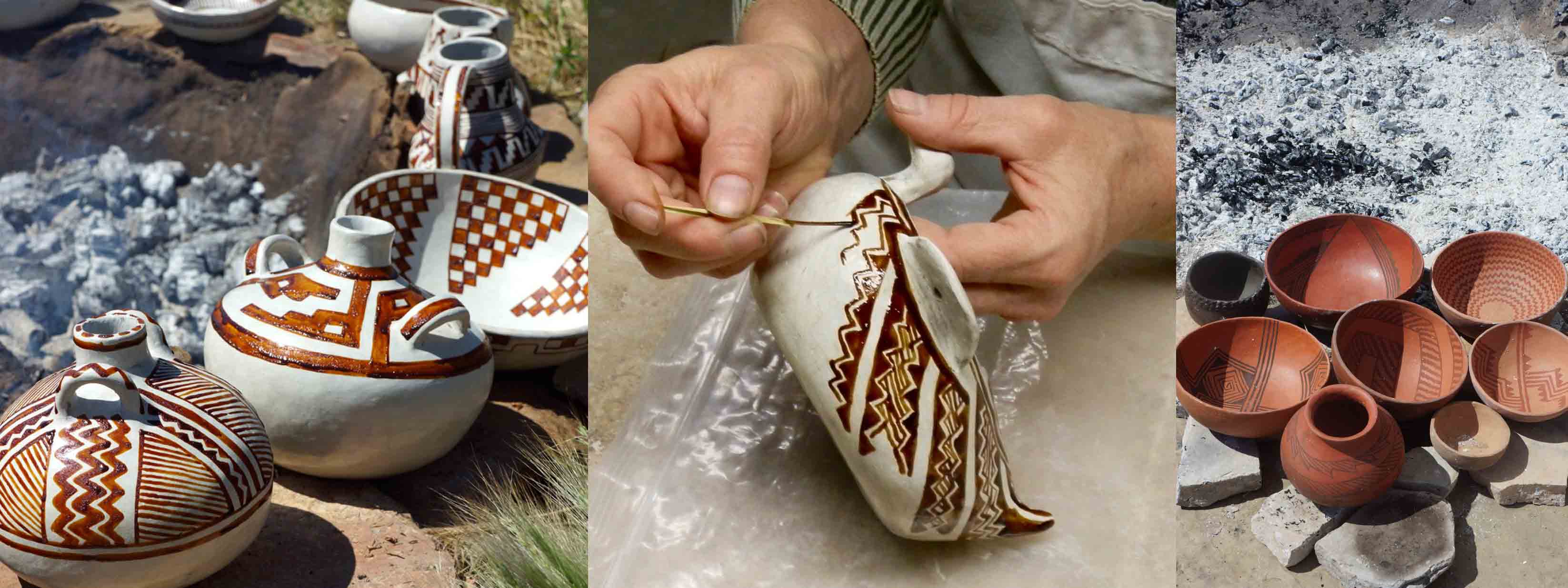
We share insights from two contemporary collectors, two replicators, and one important resource devoted to Southwestern Native clay art.
Chuck Rozanski’s collection shares space with 10 million comics in a Denver warehouse. He founded Mile High Comics in 1969 and has built it into the largest comic and collectible purveyor in North America. He began collecting Southwestern pottery more than 20 years ago and has amassed nearly 9,000 objects. His goal is to catalog, document, and create an online museum.
Rozanski’s collecting mission is clear. He values uniqueness of form, including effigies, tourist items, and abstract sculptures; uniqueness of decoration, such as rare slip colors and especially unusual avanyu (water serpent) designs; and relative obscurity of the creator.
He calls Cochiti potter Diego Romero one of his closest friends. “Diego and I sat at his potting table, sketching and laughing,” Rozanski recalls of a particularly memorable day when the two created one of Rozanski’s most personal tattoos. Rozanski’s collection contains several large bowls from Romero’s Chongo Brothers series that combine Mimbres imagery and graphic comic style with social commentary.

Rozanski doesn’t chase blue ribbons at Indian markets. He appreciates the lesser-known potters and forms. “I view this as an orphanage for lost children — generations of people who were compelled to create art not just for beauty, but out of economic need,” he says. “Native families often do not own their forebears’ pottery because of a truck payment or job loss. Just as I had to sell the last of my great comics to buy this building, they had to sell Grandma’s pot.
For Rozanski, understanding the context of why a piece was made puts a different spin on the aesthetics. “Gifted artists make spectacular pots, but what about the single mom who had to sit by the side of the road hoping someone would buy her pot so she could feed her family. I don’t look down my nose at a piece with secondary aesthetics. I see a piece from a period that perhaps I don’t understand.” There are damaged objects in his collection because they provide valuable insights.

“If I wanted another Maria or Margaret Tafoya, I could pick up the phone and have one. However, it would be much harder to find a Hopi teapot or a Zuni rain god or an Annie Fields Mojave frog, regardless of how much money I offered.”
Edward J. Guarino describes himself as “the improbable collector.” “Some people only collect the work of established artists that everyone likes — they walk around clutching a handful of blue ribbons,” says the author, educator, lecturer, and retired school teacher. “It can get competitive. I’ve seen it become like a shark feeding frenzy. I think that takes the joy out of collecting.”

Instead of vying in that competitive space, Guarino prefers collecting emerging artists. “I collect contemporary pottery because I am supporting a living artist,” he says. “I can form a relationship and ask questions. Artists are so forthcoming and generous about their work. Over the years, some of those artists have become quite well-known and I can no longer afford to acquire their work! Currently, I have a mini-moratorium on pottery because I can only fit so much in my apartment.”
Guarino offers some practical advice for any collector: “First, don’t buy anything! Do your homework, read, and look at examples in galleries, in museums, or online. Learn what makes a good piece. Educate your eye before you buy. Then, buy what you love and buy the best you can afford. Ask a gallery to allow you to buy on layaway. But never buy a pot just because of the name on the bottom.”

He also advises that you find a trusted resource. “Charles King of King Galleries is a mentor for my collection,” Guarino says. “He has impeccable taste and is incredibly honest. I’ve worked with him for more than a decade.”
The collector delights in sharing his passion. He writes a monthly column on Native art and culture for the King Galleries website and he allows pieces from his collection to go on loan. “This is American art and I want to see it exhibited as such and not simply as ethnographic or primitive art,” he says. “When an institution asks if they can display my art, I am happy to loan it because it raises awareness.”
Works from Guarino’s collection have been exhibited at Vassar College, the Brooklyn Museum, the Museum of Contemporary Native Arts in Santa Fe, and even at the 2016 Venice Biennale. Wherever they’re on view, they never fail to captivate. “When people see art by contemporary indigenous artists,” Guarino says, “they get very excited because they’ve never seen anything like it before.”

The Fine Art Of Replication
Bits of ancient pottery litter the canyons and ruins of the Southwest, but the desire to possess a piece of this history is fraught with peril. Collecting artifacts from federal land is prohibited by the 1906 Antiquities Act.
Complete jars and bowls are rare. Archaeologists say that many of those come from looted graves. Even with a provenance asserting that a piece was collected on private land (and, beware, provenance can be forged), the ethics of owning ancestral Puebloan, or Anasazi, objects are problematic. Beyond the issues of repatriation and appropriation, there lie more minefields: Several high-profile arrests have rocked the shadowy trade in these objects.

Removed from those minefields is the ethical alternative of replicas. A handful of modern artists create authentic pottery replicas of ancient Southwestern mugs, bowls, and effigies held in museum collections. These artists excavate clays and slips from canyon sources that probably were known in ancient times. They make organic paint from Bee Weed as well as grinding specific minerals for pigment, just as ancient potters did.
Unlike modern Southwest Native pottery, the ancient black and white wares were fired in trench kilns. It wasn’t until 1993 that fine artist Clint Swink deciphered the old techniques and successfully fired replica examples of prehistoric Anasazi pieces. “I believe I found a way, not necessarily the only way,” he says. “I simply rediscovered a lost art.” His legendary dedication to archaeological accuracy has created a new school of art, an aesthetically pleasing alternative to artifacts, global archaeological recognition of the value of authentic ceramic replication, and “… his labors have kindled a new appreciation for those who left behind the beauty of their art. …” (National Geographic, 4/96).
In the past 30 years he has taught his potting techniques to four generations of students through workshops and his published book, Messages From the High Desert.
Cherylene Caver remains faithful to the ancient potter at every step in her creative process: “If she painted 19 lines, I paint 19 lines,” Caver says. “I’m always asking why she did what she did.” In an attempt to find answers, Caver makes her own discoveries about the potter who came before her, finding it difficult, for instance, to paint a certain pattern until she realized the potter had been left-handed.

The unknowns draw her in to the historical context. Caver’s fascinated by an unfired bowl in the museum at Mesa Verde, part of the Colorado Plateau abandoned in the 13th century, a mystery archaeologists have not fully solved. The unknowns fire Caver’s imagination: “Why did she leave the bowl? She intended to fire it when she returned, but she never did. She had to think about that bowl.”
Swink and Caver clearly sign each piece and always represent their work as modern reproductions. Even so, Swink once spotted a pot he made in a museum. “It’s a market solution to looting,” he says. “We offer an ethical way to quench the thirst.” swinkart.com., cherylenecaver.com

First People Pots — A Website Resource
For a master’s class in Hopi pottery, visit FirstPeoplePots.com, which reflects a deep love for the creative genius of renowned Hopi-Tewa potter Nampeyo and all of Hopi art.
The website, an online catalog/database of more than 300 pieces of Native American artwork owned by a private collector, began as a thesis project for then-graduate student in graphic design Holly Chervnsik. She continues to catalog more items and add features to the website and has published Six Generations of Hopi Pottery: A Stylistic Analysis of Nampeyo Family Designs. After the owner’s death, the collection will be given to The Hopi Foundation, which plans to incorporate the collection into a future professional museum on the reservation.
FirstPeoplePots.com provides quick access to detailed information on artists and types and styles of pottery design, and it offers a look at selected artists’ career progressions. Lengthy appendices include a comparative evaluation of Nampeyo of Hano’s pottery, art history, documentation of stylistic changes, and Hopi social history. The depth of information and ease of use make it a valuable resource for collectors, galleries, and scholars. Native potters appreciate being able to see their extended family’s work, often for the first time.

More Art
Carrie Wild
Sherry Salari Sander
Valerie Hollstein














